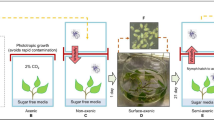Abstract
An artificial feeding system was designed for the glassy-winged sharpshooter (GWSS), Homalodisca coagulata Say (Hemiptera: Cicadellidae). The system, unlike previous systems, provided enough nutrients to GWSS to survive for 48 h. A system like this is a prerequisite to examining the potential use of paratransgenesis to interrupt transmission of Xylella fastidiosa, the bacterial pathogen causing Pierce’s disease of grape, by insect vectors. We developed a system for short-term feeding of GWSS that allows for the introduction of bacteria in liquid medium, and we have demonstrated the ability of Alcaligenes xylosoxidans denitrificans, expressing a red fluorescent protein (dsRed), to colonize the cibarial region of the GWSS foregut for up to 5 weeks post-exposure. Alcaligenes xylosoxidans denitrificans thus occupies the same region in the foregut as the pathogen, Xylella fastidiosa.
Similar content being viewed by others
Explore related subjects
Discover the latest articles and news from researchers in related subjects, suggested using machine learning.Author information
Authors and Affiliations
Rights and permissions
About this article
Cite this article
Bextine, ., Lauzon, ., Potter, . et al. Delivery of a Genetically Marked Alcaligenes sp. to the Glassy-Winged Sharpshooter for Use in a Paratransgenic Control Strategy. Curr Microbiol 48, 327–331 (2004). https://doi.org/10.1007/s00284-003-4178-2
Issue Date:
DOI: https://doi.org/10.1007/s00284-003-4178-2




